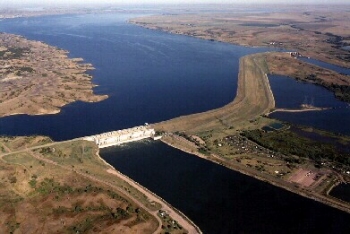Waterways
Rivers unite and divide countries. They are liquid barriers and
flowing highways. In some places they run through countries; in
others, they become the boundaries between nations. Except for
Australia and Antarctica, continents have great rivers that
determine how and where people live. The Congo, Niger, and Nile
shape African topography and culture. The Rhine and Danube do the
same for Europe; the Volga is synonymous with Russia. In South
America the Amazon defines the continent, creating the huge rain
forests that cover huge expanses, carrying everything from people to
sediment to the ocean. Across Asia the Mekong and Yangtze affect
commerce, and in India, the Ganges is a site for religious
cleansing. The delta of the Tigris and Euphrates, in Iraq, has often
been considered the “cradle of civilization.” the
same for Europe; the Volga is synonymous with Russia. In South
America the Amazon defines the continent, creating the huge rain
forests that cover huge expanses, carrying everything from people to
sediment to the ocean. Across Asia the Mekong and Yangtze affect
commerce, and in India, the Ganges is a site for religious
cleansing. The delta of the Tigris and Euphrates, in Iraq, has often
been considered the “cradle of civilization.”
As long as there have been civilizations, people have been bridging,
damming, channeling—using—rivers to make their lives easier. Of all
the ways that rivers can be changed, dams alter the personality and
flow of a river more than any other manmade structure. Whole towns
have been moved or buried under water when large dams have been
constructed. These gigantic lakes, reservoirs, are used for
recreation and power generation. With dams, people control flow of
the river. Few large rivers, those that consistently flow year
round, have not been dammed. In South Dakota, alone, four dams block
the Missouri River. A debate continues in the Pacific Northwest
about whether to destroy old dams or not. Because they impede salmon
migration, dams have been the scourge of fisherman,
environmentalists, and Native American tribes.
Water and rivers usually mean life. Like people, animals are drawn
to rivers. Many of the world’s wide variety of plants can be found
along the banks of great rivers—most notably tropical rivers like
the Amazon. As early explorers, like Lewis and Clark, traveled up
and down big rivers into unknown reaches, they discovered dozens of
new species along the banks. Though they can have an awesome
destructive force when they flood, rivers regularly and normally
flood as part of a natural cycle. As much as man tries to harness
rivers, they still meander, changing their courses as if they have
minds of their own.
The longest waterway in the United States, and fourth longest in the
world, is the Missouri-Mississippi system, running from the
headwaters of the Missouri in Montana to Louisiana and the Gulf of
Mexico—more than 3,800 miles. Technically, the Missouri River flows
from the Rocky Mountains in the west to its confluence with the
Mississippi River at St. Louis, Missouri, passing through Montana,
North Dakota, South Dakota, forming the border between Iowa and
Nebraska and part of the border between Kansas and Missouri before
bending east through the heart of the Show Me State.
|



 the
same for Europe; the Volga is synonymous with Russia. In South
America the Amazon defines the continent, creating the huge rain
forests that cover huge expanses, carrying everything from people to
sediment to the ocean. Across Asia the Mekong and Yangtze affect
commerce, and in India, the Ganges is a site for religious
cleansing. The delta of the Tigris and Euphrates, in Iraq, has often
been considered the “cradle of civilization.”
the
same for Europe; the Volga is synonymous with Russia. In South
America the Amazon defines the continent, creating the huge rain
forests that cover huge expanses, carrying everything from people to
sediment to the ocean. Across Asia the Mekong and Yangtze affect
commerce, and in India, the Ganges is a site for religious
cleansing. The delta of the Tigris and Euphrates, in Iraq, has often
been considered the “cradle of civilization.”

